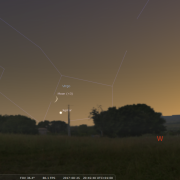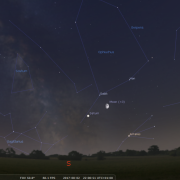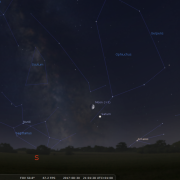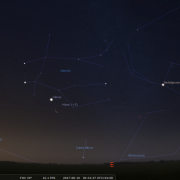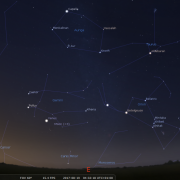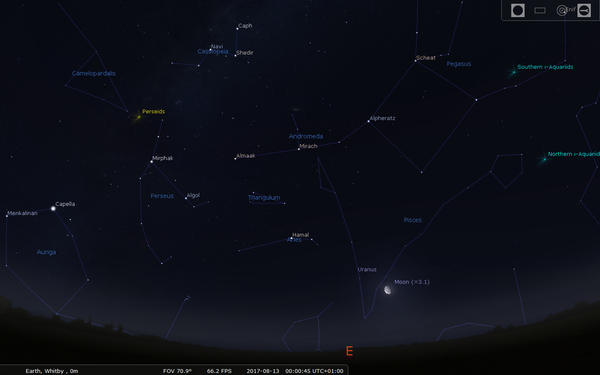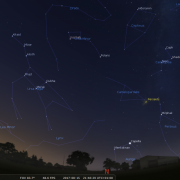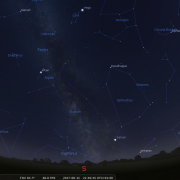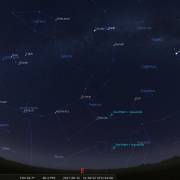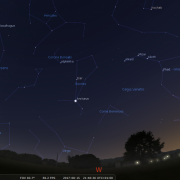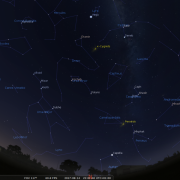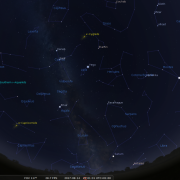In this month's Sky Notes:
Planetary Skylights

 Jupiter is starting to slide down into the brighter evening twilight low in the WSW, but remains on view throughout August, setting by 21:00h at the end of the month. Look for a bright object as dusk falls. Although Jupiter will be lower, it is nevertheless well worth observing, especially at the start of August. Look in particular for the dark banding across the disk and the Galilean moons; the configuration of which alters each night. The Moon lies nearby Jupiter on the 25th.
Jupiter is starting to slide down into the brighter evening twilight low in the WSW, but remains on view throughout August, setting by 21:00h at the end of the month. Look for a bright object as dusk falls. Although Jupiter will be lower, it is nevertheless well worth observing, especially at the start of August. Look in particular for the dark banding across the disk and the Galilean moons; the configuration of which alters each night. The Moon lies nearby Jupiter on the 25th.
 As twilight falls Saturn is located quite low in the SWS in the constellation of Ophiuchus – the Serpent Bearer. Look for a conspicuous pearly white ‘star’ in that direction. A modest telescope will reveal the ring system, which is orientated favourably at present; but due to low altitude patience is required at the eyepiece, waiting for those tantalising steady seeing moments. Look for the major gap in the rings, the Cassini division) and Saturn’s largest moon, Titan, visible as a speck of light close by. Our moon lies nearby on the 2nd and 3rd of Aug and again on the 30th.
As twilight falls Saturn is located quite low in the SWS in the constellation of Ophiuchus – the Serpent Bearer. Look for a conspicuous pearly white ‘star’ in that direction. A modest telescope will reveal the ring system, which is orientated favourably at present; but due to low altitude patience is required at the eyepiece, waiting for those tantalising steady seeing moments. Look for the major gap in the rings, the Cassini division) and Saturn’s largest moon, Titan, visible as a speck of light close by. Our moon lies nearby on the 2nd and 3rd of Aug and again on the 30th.
 Venus is visible in the pre-dawn sky located low in the ENE from around 03:00h. The brilliant ‘morning star’ should be unmistakeable, especially as we head deeper into August as nights (and early mornings) grow darker. The moon lies nearby on the 19th.
Venus is visible in the pre-dawn sky located low in the ENE from around 03:00h. The brilliant ‘morning star’ should be unmistakeable, especially as we head deeper into August as nights (and early mornings) grow darker. The moon lies nearby on the 19th.
Meteors & Comets
One of the highlights on the astro-calendar, the Perseid meteor shower, peak on August 12th this year, the problem being this coincides with a waning gibbous moon, rendering many of the fainter meteors invisible, particularly post midnight.
Perseids are so called because their radiant; the location in the sky from which they appear to emanate, lies within the constellation of Perseus. In some regions of the world the Perseids are also known as "The Tears of St. Lawrence", or the ‘Fiery Tears’ because the feast day of that saint falls on Aug 10th, just two days before the meteor peak.
Perseids are associated with debris left by the periodic comet Swift Tuttle, deposited over many thousands of years. Each August Earth ploughs through strands of this debris, giving rise to the Perseid shooting stars. This 'debris' is typically the size of instant coffee granules, with the occasional pea or marble sized fragment which ‘burn up' (ionize) at altitudes of around 60 miles reaching speeds of 39 - 45 miles per second.
As for observing, all is not quite lost, as Perseids will be visible in the pre-midnight sky on the 12th, (when most casual observers go out to watch anyway) As we draw closer to midnight and into the early morning hours of the 13th, (usually the optimum time for Perseids) only the brighter shooting stars will be visible, light from the moon drowning out the remainder. Expect actual observed numbers of 15- 25 from 22:00h -midinght, and less than 8 per hour post midnight. The most rewarding regions of the sky for spotting Perseids lie within the 'Summer Triangle' - visible high to the south, the 'Plough' – high to the NW and the Square of Pegasus – midway up in the east.
August 2017 Sky Charts
|
Looking North
Mid-August - 21:45h |
Looking South |
|
Looking East
Mid-August - 21:45h |
Looking West
Mid-August - 21:45h |
| Northern Aspect Mid-August - 22:00h |
Southern Aspect Mid-August - 22:00h |
Additional Image Credits:
- Planets and Comets where not otherwise mentioned: NASA
- Sky Charts: Stellarium Software
- Log in to post comments

